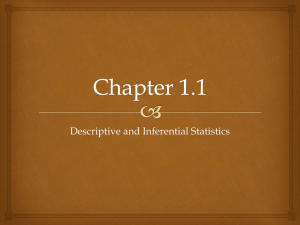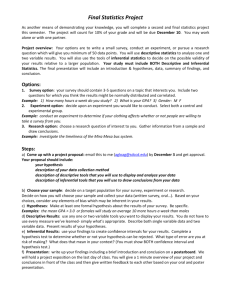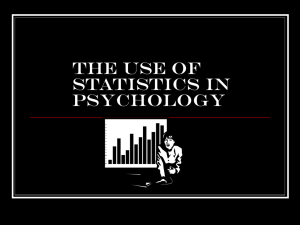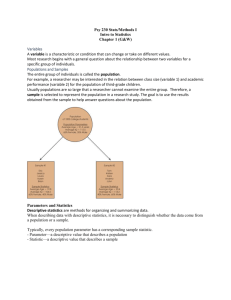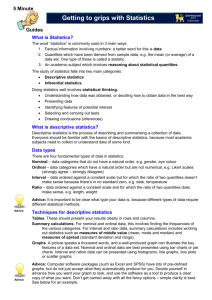Mostert's Introduction to Statistics in Research
advertisement
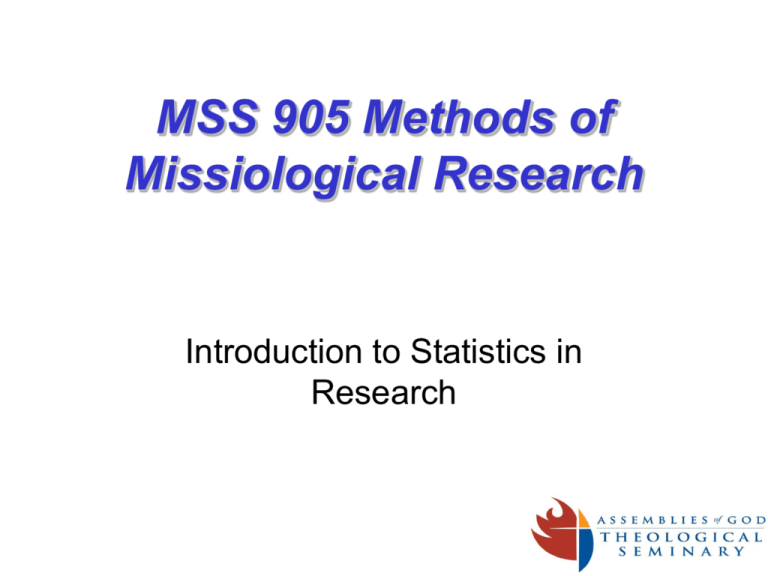
MSS 905 Methods of Missiological Research Introduction to Statistics in Research Introductory Concepts • Empiricism: using direct observation to obtain knowledge • Empirical research: acquiring knowledge by using scientific observational techniques – Experimental research using dependent and independent variables to identify causal relationships in experimental and control groups – Nonexperimental research are also called descriptive studies (no treatments; historical analysis, case study, program evaluation, etc) 4 Levels of Quantitative Measurement (NOIR) 1. Nominal: (“categorical”) lowest, least precise, different categories (religious affiliation, gender, state) 2. Ordinal: difference plus categories can be ranked in order from high to low (height, weight, favorite subjects) 4 Levels of Quantitative Measurement (NOIR) 3. Interval: plus it can specify the amount of distance between categories (differences in inches between ten individuals, miles between five cities) 4. Ratio: plus true zero, can do proportions or ratios (not important difference from interval) 4 Levels of Quantitative Measurement (NOIR) What are the following? • Strongly agree/agree/disagree/disagree • Racial categories? • IQ scores? • Temperature? • Freshman, sophomore, junior, senior? Types of Statistics 1. Descriptive: to summarize data 2. Corelational: special subgroup of descriptive statistics that describe the relationship between two or more variables for one group of participants 3. Inferential: tools that can tell us how much confidence we can have when we generalize findings from a sample to a population Descriptive Statistics • f stands for frequency, or the number of cases or times a number or attribute appears “ a score of 17 (f = 23) appeared the most” • N is the number of participants (N= 78) • Frequency distribution: the shape of a set of scores • Normal distribution: a bell shaped curve • Skewed distribution (positive and negative) Descriptive Statistics • X (pronounced X=bar): the mean, the most frequently used average • Median is an alternative average: it has 50% of the cases above it and 50% below; the “middle point” • Mode is the most frequently occurring score in a distribution Descriptive Statistics • Variability refers to the differences among scores of participants • Measures of variability are a group of statistics that are designed to describe the amount of variability in a set of scores • Range: the simplest statistic to indicate variability (the difference between the highest and the lowest scores) Descriptive Statistics • Standard deviation: the most frequently used measure of variability (dispersion, spread of scores) • It provides an average of how far all the participants scored away from the mean – The more they differ from the mean of their group the higher the standard deviation • Standard deviation can be plotted on a normal curve (see handout) Types of Statistics 1. Descriptive: to summarize data 2. Corelational: special subgroup of descriptive statistics that describe the relationship between two or more variables for one group of participants 3. Inferential: tools that can tell us how much confidence we can have when we generalize findings from a sample to a population Corelational Statistics • Correlation refers to the extent to which two variables are related across a group of participants (eg SAT scores and first-year GPA in college; spiritual maturity scores and church attendance) – Can be positive or negative or orthoganal – NOT causal (for that you need an experimental design) – Pearson r: correlation coefficient (-1.00 to 1.00) Types of Statistics 1. Descriptive: to summarize data 2. Corelational: special subgroup of descriptive statistics that describe the relationship between two or more variables for one group of participants 3. Inferential: tools that can tell us how much confidence we can have when we generalize findings from a sample to a population Types of Statistics 1. Descriptive: to summarize data 2. Corelational: special subgroup of descriptive statistics that describe the relationship between two or more variables for one group of participants 3. Inferential: tools that can tell us how much confidence we can have when we generalize findings from a sample to a population Inferential Statistics • Population: all the members of a group of interest to a researcher • Sample: a representative group of members from the total population • Null hypothesis: that the true difference between the mean scores of two groups is zero (ie. there is no difference) – Has to be rejected first before an alternative hypothesis can be entertained Inferential Statistics • Null hypothesis actually says that the observed difference between the means of two sets of scores was due to sampling error • Significance tests (like t Test) are applied to the data that yield a probability that the null hypothesis is true (“p”) – p<.05 (probability is only 5 in 100) – P<.01 (probability is only 1 in 100) Inferential Statistics • When you test the null hypothesis to determine the difference between means – Use a t Test if there are two means – Use a F Test if there are two or more means to be tested (this is referred to as the ANOVA or analysis of variance) Scales “A data measure that captures the intensity, direction, level or potency of a variable construct along a continuum” – Often used in survey research – Most scales are at the ordinal level of measurement Scales 1. Likert Scale – – – – – Widely used in survey research Ordinal-level measure of attitude Examples on p. 208, Box 7.8 Minimum of 2 categories, but normally 4 to 8 Sometimes reverse scored to avoid response set (tendency to agree with every question) – Can be used to form an index of opinion Scales 2. Thurstone scaling – Group of judges rank many items into piles along a continuum – Seldom used due to limitations 3. Bogardus Social Distance Scale – Measures the social distance separating ethnic groups – Example p. 213, Box 7.11 Scales 4. Semantic Differential – – An indirect measure using polar opposite adjectives or adverbs Subjects indicate their feelings by marking the spaces between these opposites (7.12) 5. Guttman Scaling – – A cumulative scale to determine whether relationships exist among indicators A scale based on data that has been collected already, to determine if a hierarchical pattern exists among responses Hypothesis and Causality 1. “Research has proved”: only in journalism, advertisements, courts of law; not in scientific language (TV Dr. Jarvic, or eharmony.com) 2. Rather: “evidence supports, or confirms the hypothesis” 3. Other ways to state a causal relationship (Box 6.7, p. 163)
